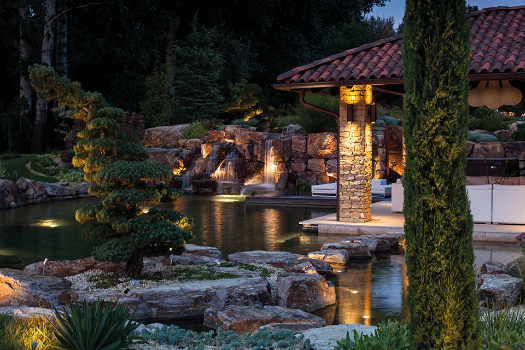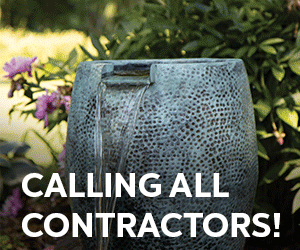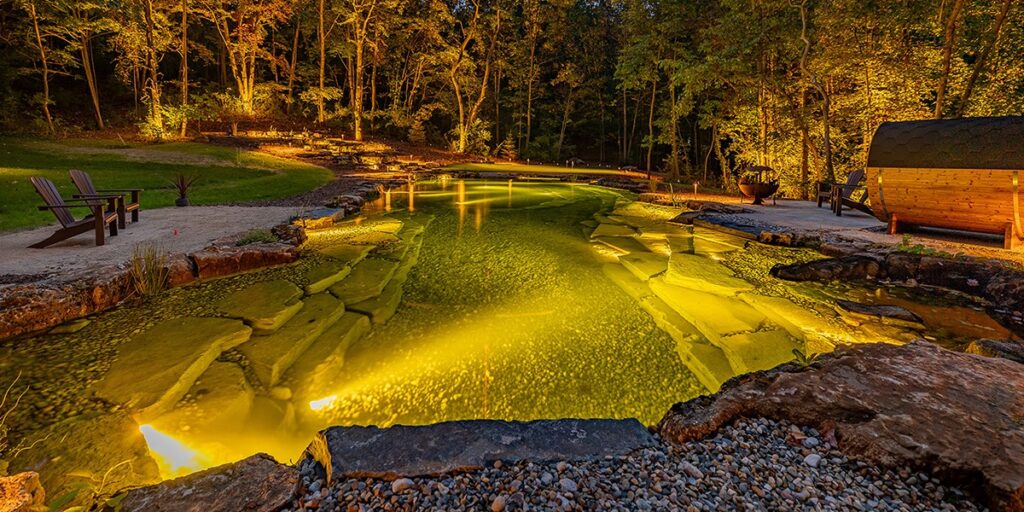
package for each system.
As the interest and popularity of natural swimming pools (NSP) and recreational ponds continues to grow in North America, we see an increase in questions about how they work, what products are recommended and what should be considered when designing them.
One of the first questions that often comes up is, “What is the difference between an NSP and a recreational pond?” In our industry there is a variety of opinions and ideas as to what defines a natural swimming pool and a recreational pond. The intent of this article is to continue and add to the conversation about this exciting and growing category — not to tell anyone the right or wrong way to do anything. The more we work together to discuss topics like these, the better off the category and the more satisfied our customers will be.
So, What’s the Difference?

A straightforward way to answer this question is to determine how the feature will be used and how it will look. If a client wants to use the feature like a swimming pool and have a non-chemical natural solution, I would call it a natural swimming pond. If the client wants to have a feature that looks more like a traditional pond or water garden, and swimming is not a key element, I would call it a recreational pond. An NSP will have some of the common characteristics of a traditional pool, like a defined swim area and safe ways to enter and leave the feature (ingress and egress). Having these characteristics will make the feature look different from a traditional pond.
Our company is involved with a variety of trade organizations and common interest groups around the world that support the growth and advancement of the NSP category. One of the common threads that runs through these organizations is the goal to expose more people to the features and benefits NSPs. Another goal is to provide general best practices and guidelines, which can help installers and clients benefit from the expertise and past experience of people that have successfully worked in this category for many years.
Guiding the Conversation about Natural Swimming Pools
Recently the International Organization for Natural Bathing Waters (IOB) and the Association for Swimming Pond and Natural Swimming Pools (ASPNSP) published The Common Essentials in planning, building and maintaining NSPs.

The Common Essentials is a helpful tool in guiding the conversation about NSPs. NSPs are nature-based solutions, engineered systems that use principles and processes known from nature. To clarify and purify water, NSPs use exclusively mechanical and biological methods to reduce nutrients.
Each NSP is the result of a professional implementation of the customer’s request and planning process based on scientific approaches and state-of-the-art technology. The resulting plan describes the water-treatment process and predicts excellent bathing water quality. When the NSP is in operation, the planned water-treatment process must meet prediction and expectation on water quality.
The Common Essentials goes on to say that clients should be informed about all the aspects of an NSP, including maintenance. They should understand what is to be expected in terms of living water quality and the presence of wildlife. Existing applicable building and construction regulations must be followed. This applies as well to all safety regulations existing for swimming pools.
Maintaining Water Quality in a Natural Swimming Pool
An NSP is divided into a bathing area or areas, and a biological treatment area or areas. Surface water runoff from the property surrounding the NSP shall not flow into the NSP. An NSP must be sealed, i.e., isolated from the ground under and around the NSP. Materials used in NSPs should not pollute or contaminate the water and environment. This also includes limiting the introduction of phosphorous.

During the planning process, the water that will be used to fill the NSP should be evaluated and adjusted as needed. For public NSPs, local water-testing regulations are to be followed. Private NSPs are to be tested as needed.
When plants are used, native plants are preferred. Plants deemed to be invasive species in the locale where the NSP is located are not to be used. Plants used in an NSP should be cultivated for that purpose and not be harvested from nature.
After reading The Common Essentials, I think that many will agree that they are common sense and best practices that many professionals already incorporate into their business.
What About Fish?
One of the questions that comes up after reviewing The Common Essentials is, “What about fish in an NSP?” While swimming with fish in a pond is enjoyed by many people and is happening every day, this can also be a contentious issue for others.


two separate features — an NSP and a koi pond.
I think that the question should be, “What is the best way to allow a client that wants to enjoy swimming in natural chemical-free water and also keep and enjoy fish?” One answer is to design two separate systems that are visually one natural feature. Separating the systems allow us to filter and maintain them differently and, in the long term, make for a natural, healthy, easy-to-maintain feature.
Whatever type or style of feature is chosen, it is especially important to understand the client’s expectations and match them up with the best products and practices available to ensure that the result is to everyone’s satisfaction.
For more information on The Common Essentials and to learn more about the IOB and the ASPNSP, please check out www.iob-ev.com/en/ and www.aspnsp.org/home.


